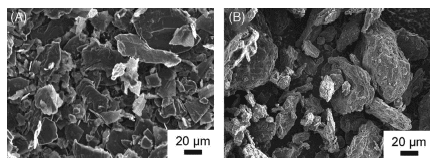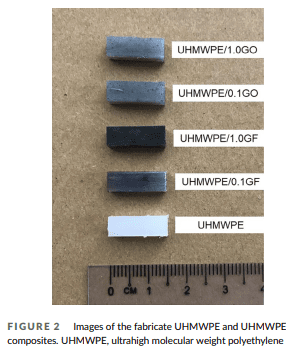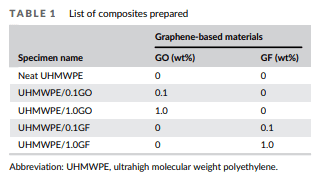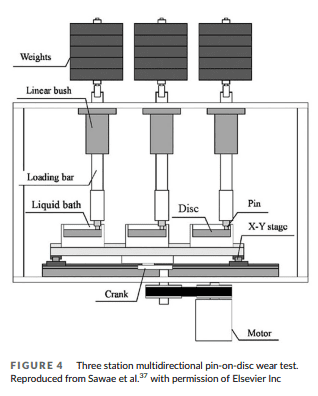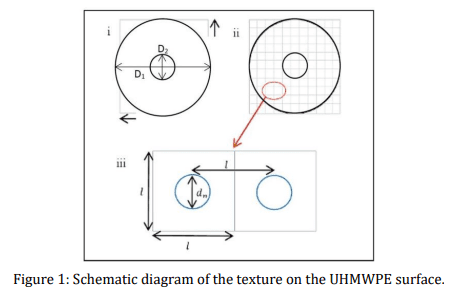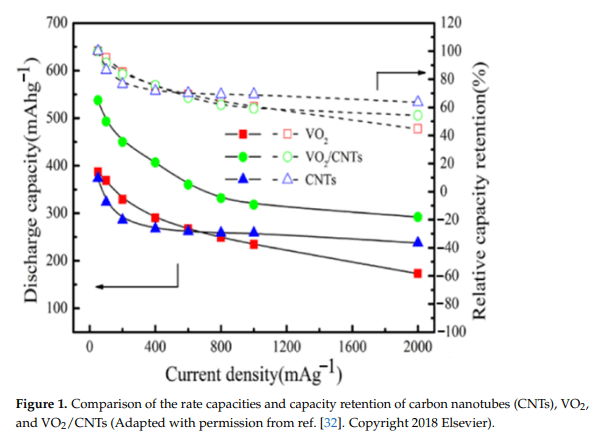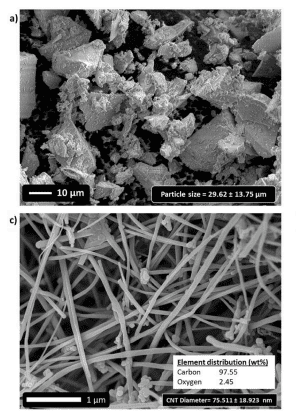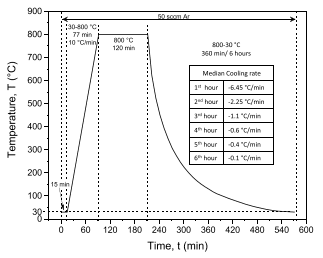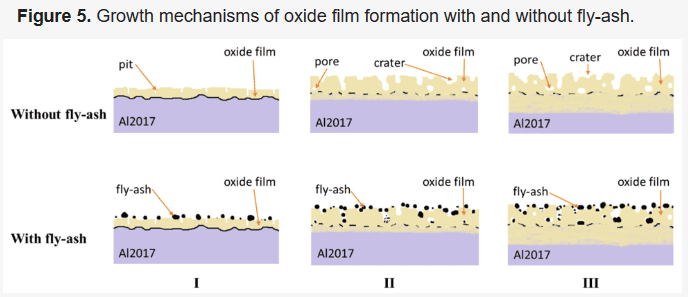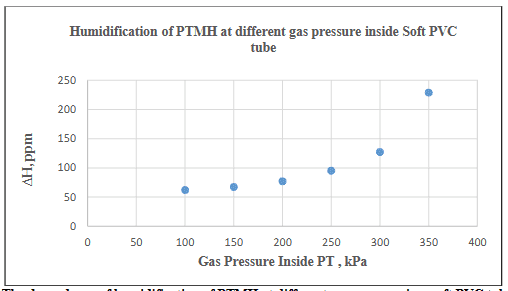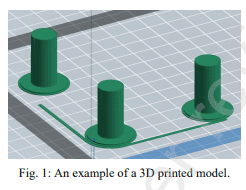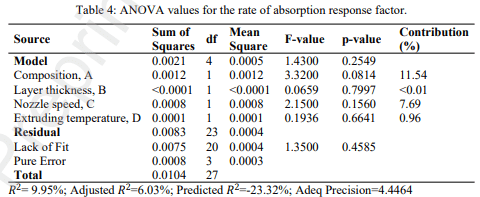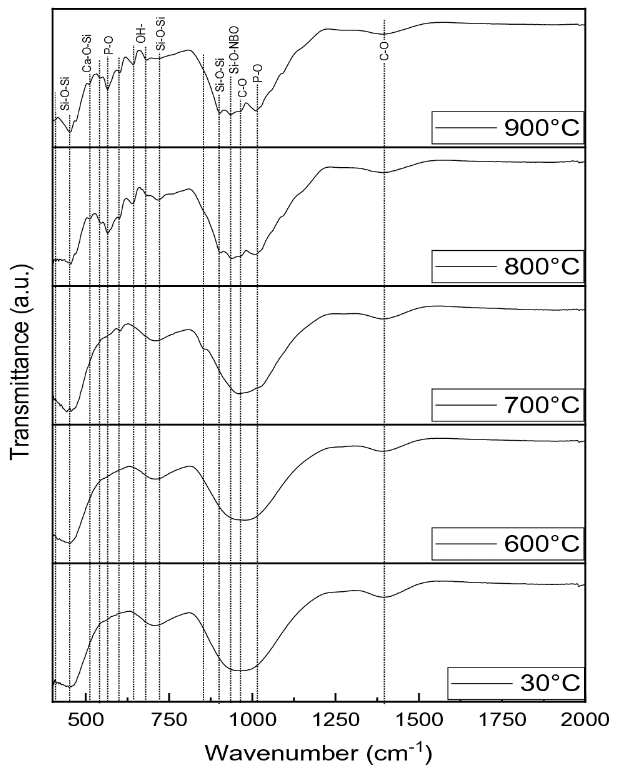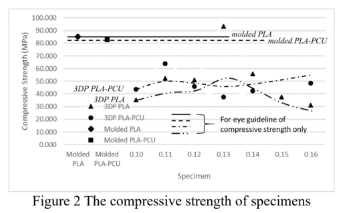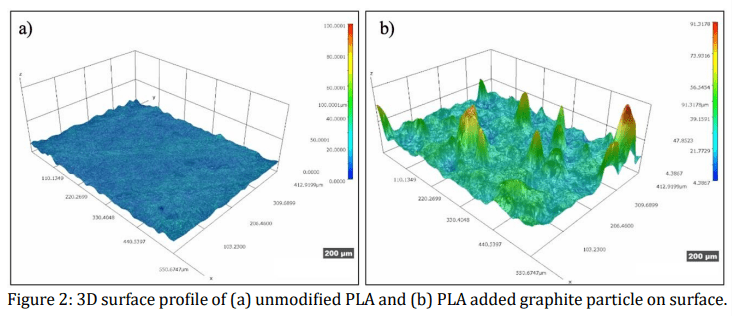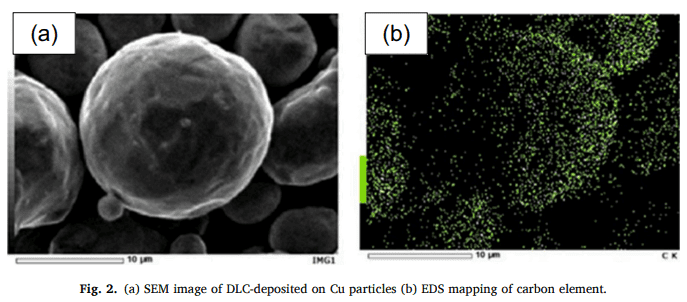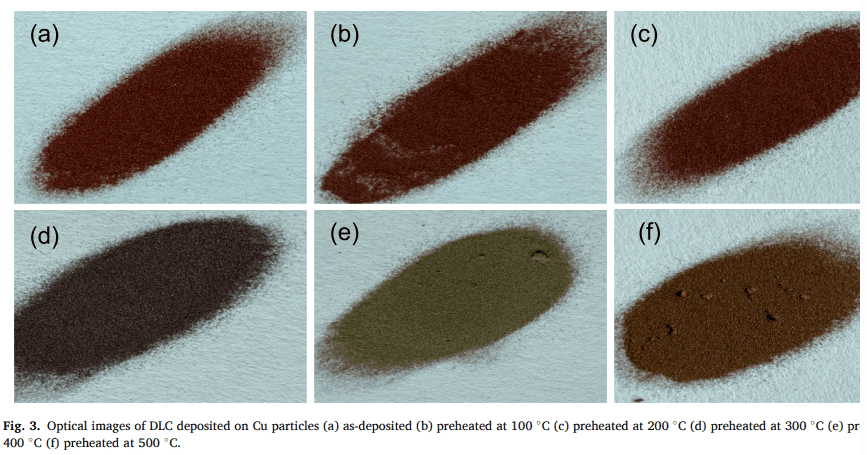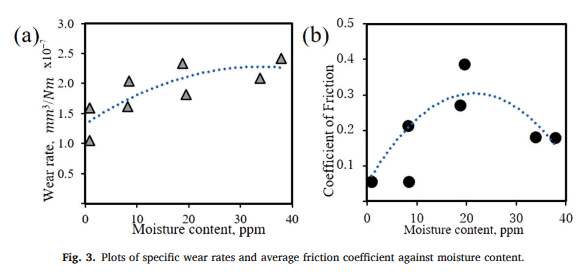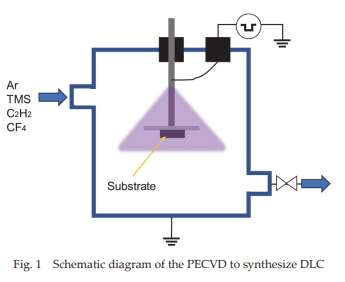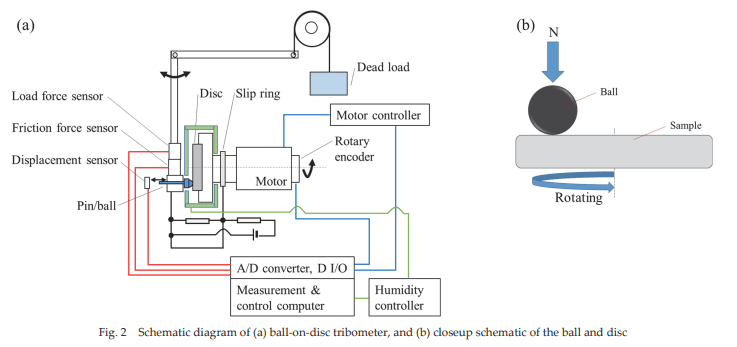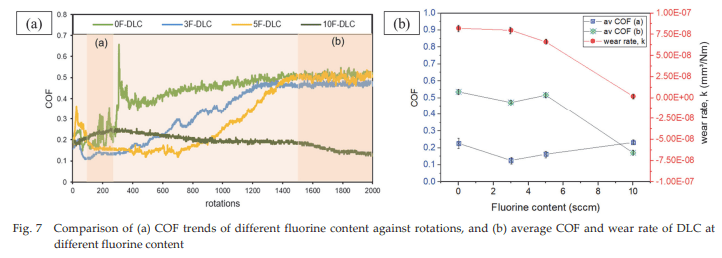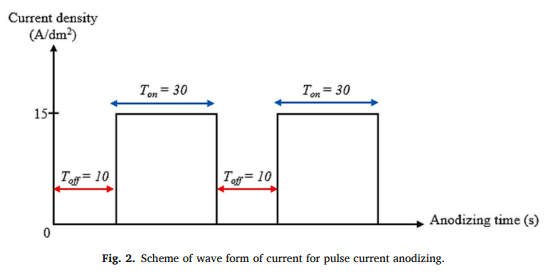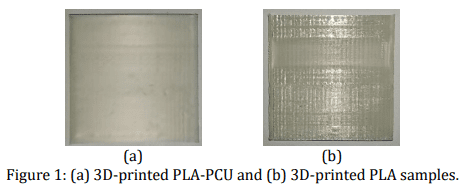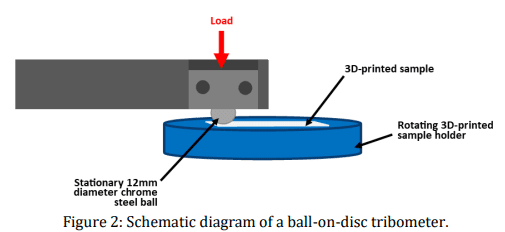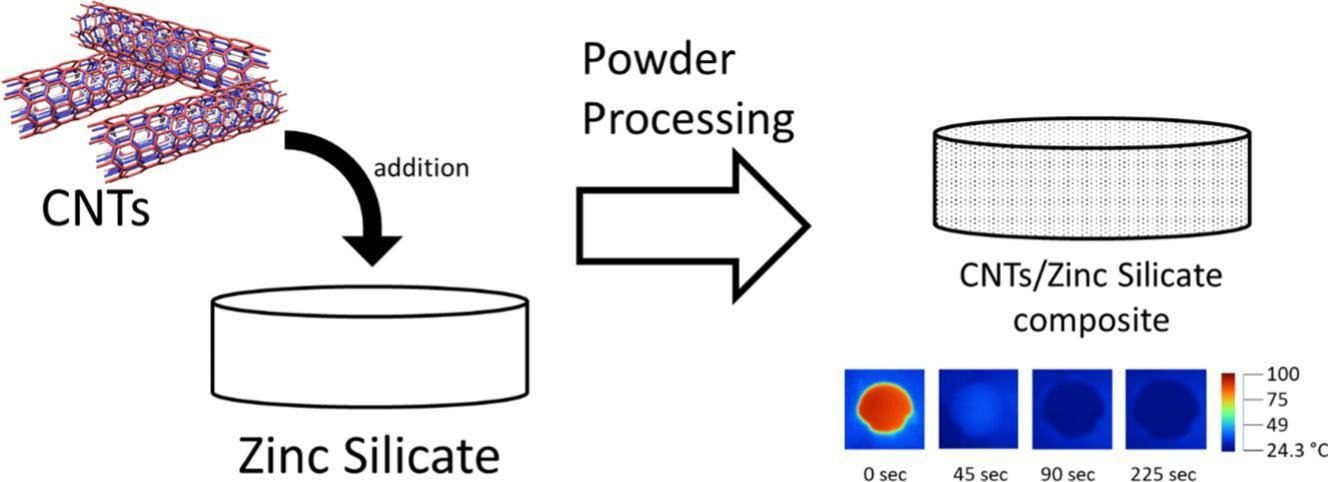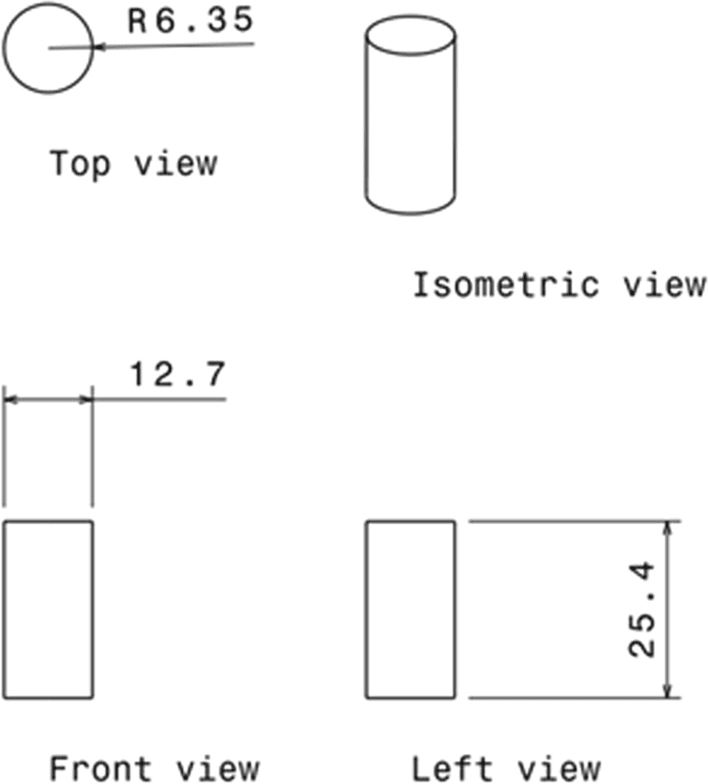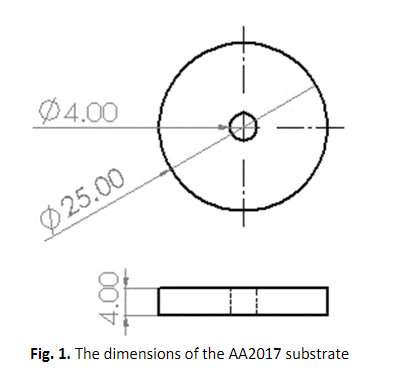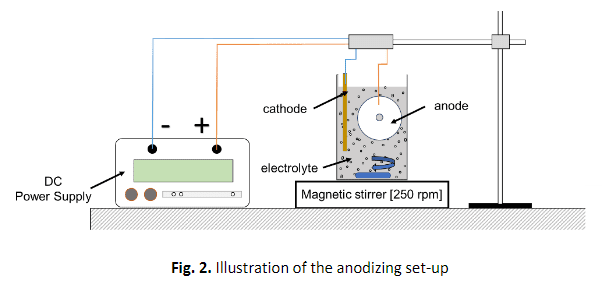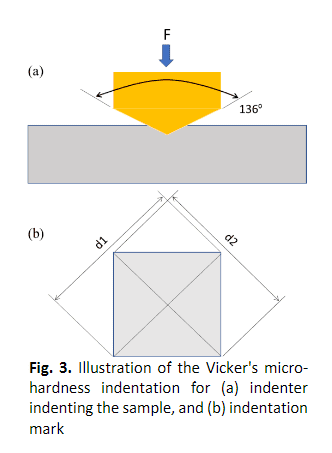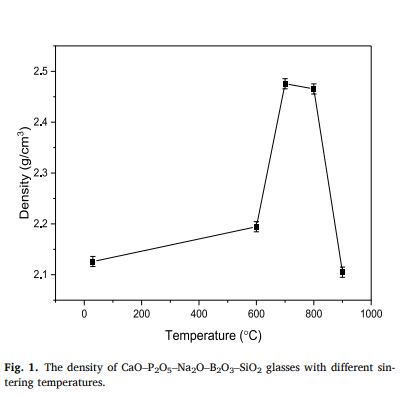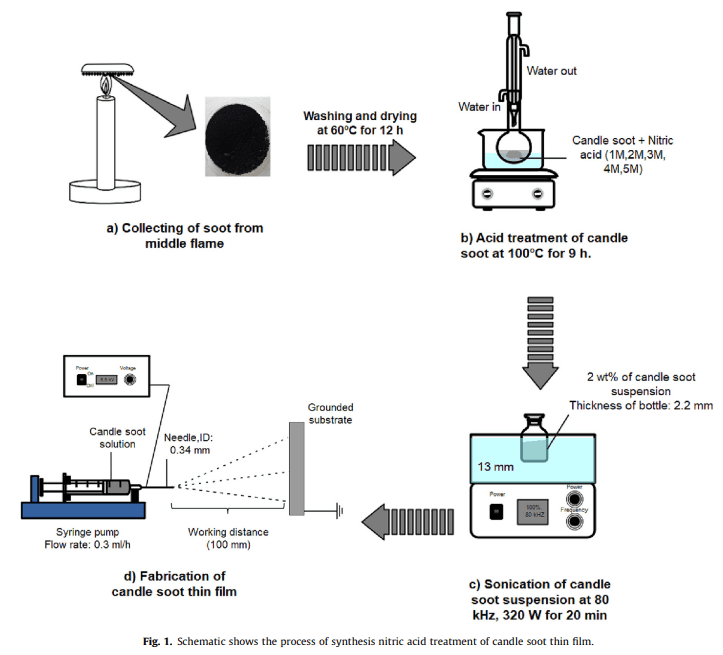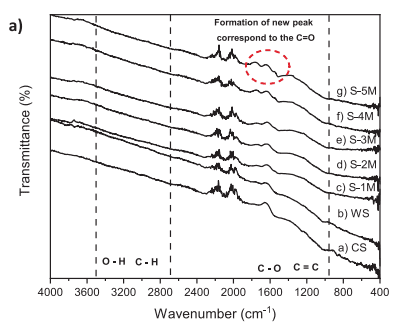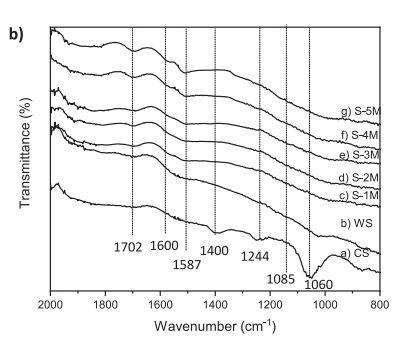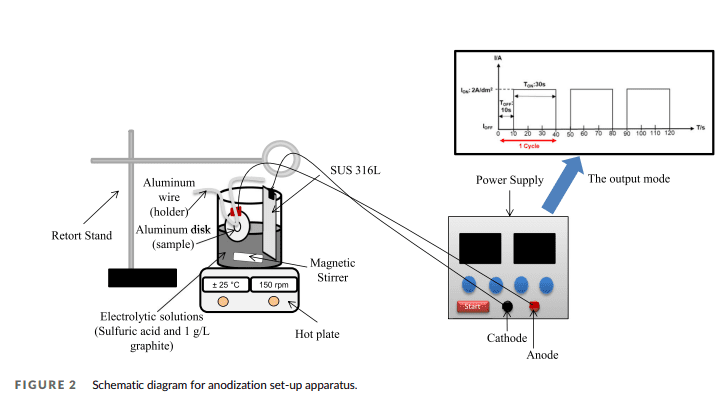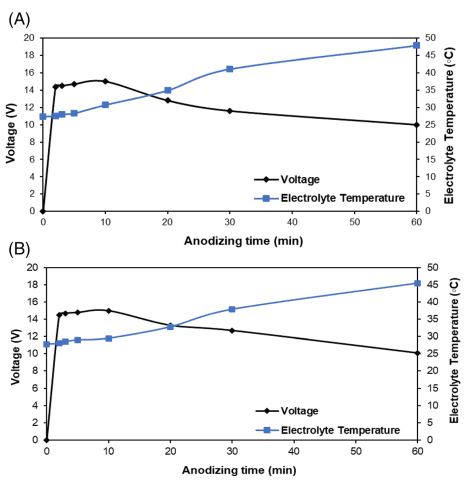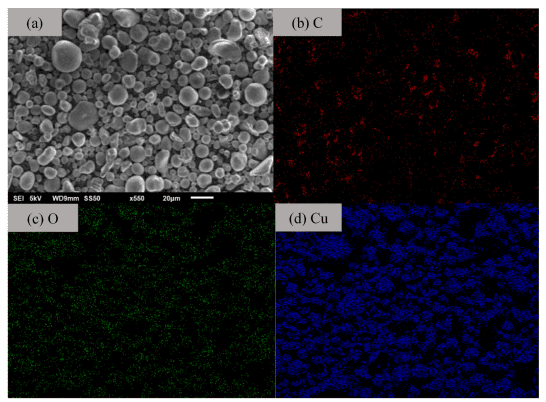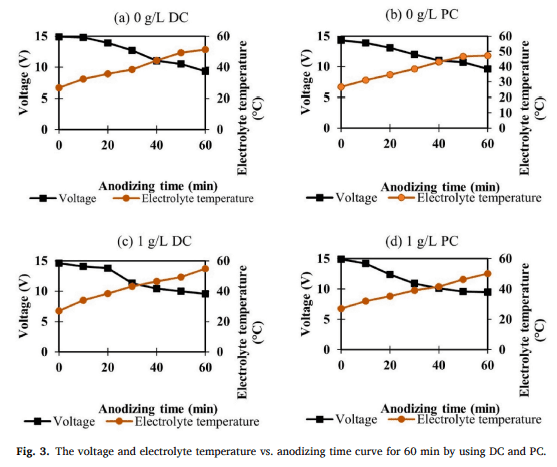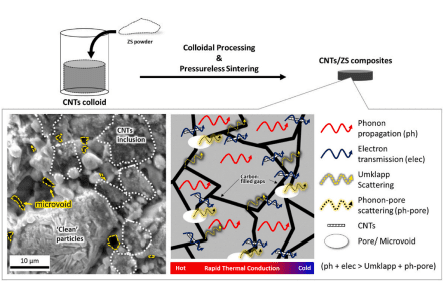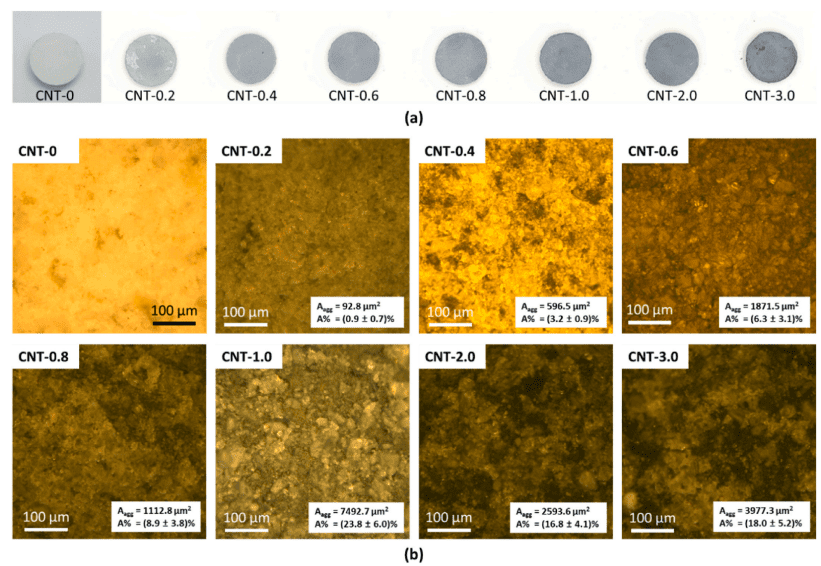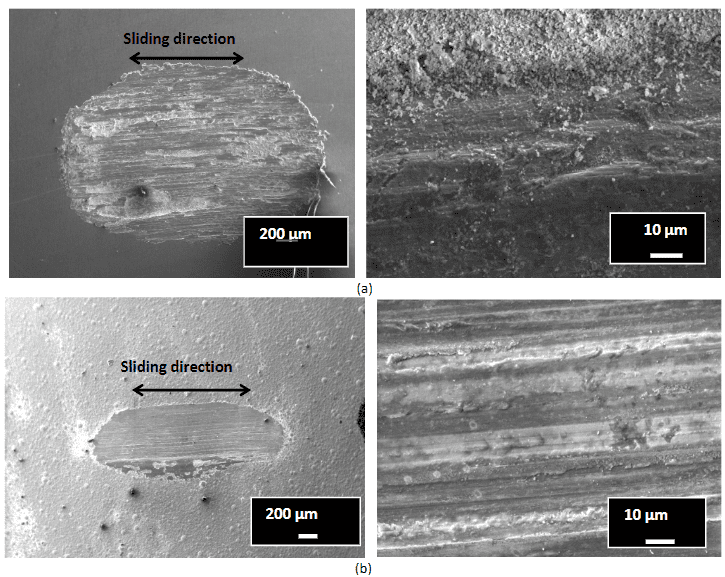Title: The relations between wear behavior and basic material properties of graphene‐based materials reinforced ultrahigh molecular weight polyethylene
Abstract:
This article aims to investigate the influence of reinforcing graphene oxide (GO) and graphite flakes (GF) fillers into ultrahigh molecular weight polyethylene (UHMWPE) for orthopedic application. These fillers were expected to physically bond to UHMWPE, thus can enhance the subsurface strength, improving the wear behavior of the composites. UHMWPE/GO and UHMWPE/GF composites were prepared at 0.1 and 1.0 wt% by melt-blending, followed by a compression molding technique. A multidirectional pin-on-disc wear test was performed to simulate the kinematic of hip application. Whilst getting exposed in the artificial in-vivo lubricant bath (30 v/v% diluted bovine serum). Following this, the wear mechanism fostered by each filler (GO and GF) was determined by wear features obtained from the optical microscope and scanning electron microscope (SEM). The crystallinity degree and crystal defect were assessed using x-ray diffraction (XRD). The mechanical properties of fabricated composites were evaluated by using a universal testing machine and Vickers microhardness. We found that UHMWPE/GO has the lowest specific wear rate due to the improved subsurface strength, as the reduction of a weak adhesive point was observed on the worn surface. Meanwhile, higher GF content (1 wt%) in UHMWPE displayed a lower specific wear rate than neat UHMWPE after completing the 10 km sliding distance attributed to the filler resurfaced, responsible for providing a strong resistance of the shear stress applied upon sliding with the metal counterface. Interestingly, the hardness and tensile strength for both UHMWPE/GO and UHMWPE/GF increased, although the crystallinity percentage was declining compared to neat UHMWPE.
Title: The effect of humidity on friction behavior of hydrogenated HIPIMS WC: H coatings
Abstract:
The study of the effect of humidity on friction behavior in HiPIMS (High Power Impulse Magnetron Sputtering) W-C:H coating/steel ball system confirmed the formation of transfer layer adhered to the ball and consisting of hydrogenated carbon, ferritungstate and small amounts of tungsten (sub)oxides and iron oxides. The corresponding mechano(tribo)chemical reactions driven by flash temperature in the sliding asperities involved oxidation, water vapor dissociation and carbon hydrogenation. Such composition agreed with the results of modelling based on the minimization of free Gibbs energy in the mutually interacting thermochemical reactions. The applicability of modelling to friction was attributed to fast reactions among microscopic asperities eliminating kinetical factors. In inert atmospheres, oxidation and hydrogenation were suppressed and friction seemed to be controlled by the amount of additional carbon.
Title: Carbon-Based Materials Reinforced Ultrahigh Molecular Weight Polyethylene and Biocomposites
Abstract:
The chapter represents a comprehensive review of inorganic particles reinforced the ultra-high molecular weight polyethylene (UHMWPE) to promotes better operational properties as compared to pure UHMWPE for orthopaedic applications. A strong interfacial adhesion between UHMWPE matrix-based particle filler is believed to be the major factor influencing the UHMWPE based composite material’s properties outcome. Hence, graphene oxide and graphite were reviewed as the potential reinforcement particles due to its special additional properties; biocompatible, high thermal conductivity, hydrophilic behavior and could act as a nucleating agent, which rarely found in other type of materials in current market. UHMWPE based carbon-based reinforced composite with optimum processing parameters and wt% shows improved mechanical properties. UHMWPE reinforced cabon-based particle exhibited remarkable mechanical properties which have the potential to be the alternative materials for joint orthopaedic applications.
Title: Fabrication and tribological characterization of aluminium alloy by using photochemical machining
Abstract:
Photochemical texturing (PCT) is a widely used method to modify physical topography of the surface nearly all type of materials. However, the usage of this method is the most commonly used in microelectronic mechanical systems (MEMS) industries. While there have been few reported studies on the use of PCT technique for metal surfaces and there has been very limited work on the tribological characteristics from such surfaces. Therefore, the objective of the present work was to gain a better understanding on the wear and friction behaviour of textured aluminium alloy, AA2017-T4 by considering their geometrical texture characteristics. In this study, AA2017-T4 disks have been texturized into circular dimples with different area density (0 to 20%) and depth (5 to 15µm). Ball on disc tests were performed under dry condition. The worn surface of AA2017-T4 disks was analyzed to understand the wear mechanism and durability of the textured surface during testing. The results indicate that a higher density of circular dimples (20%) had less wear and a lower coefficient of friction compared to non-textured disk. The results suggest that the tribology performance is only dependent on the surface area density but does not influence by depth characteristics
Title: Waste NR Latex Based-Precursors as Carbon Source for CNTs Eco-Fabrications
Abstract:
In this work, the potential of utilizing a waste latex-based precursor (ie, natural rubber glove (NRG)) as a carbon source for carbon nanotube (CNT) fabrication via chemical vapor deposition has been demonstrated. Gas chromatography-mass spectroscopy (GC-MS) analysis reveals that the separation of the lightweight hydrocarbon chain from the heavier long chain differs in hydrocarbon contents in the NRG fraction (NRG-L). Both solid NRG (NRG-S) and NRG-L samples contain> 63% carbon,< 0.6% sulfur and< 0.08% nitrogen content, respectively, as per carbon-nitrogensulfur (CNS) analysis. Growth of CNTs on the samples was confirmed by Raman spectra, SEM and TEM images, whereby it was shown that NRG-S is better than NRG-L in terms of synthesized CNTs yield percentage with similar quality. The optimum vaporization and reaction temperatures were 350 and 800◦ C, respectively, considering the balance of good yield percentage (26.7%) and quality of CNTs (ID/IG= 0.84±0.08, diameter≈ 122 nm) produced. Thus, utilization of waste NRG as a candidate for carbon feedstock to produce value-added CNTs products could be a significant approach for eco-technology.
Title: Effect of Protein Interactions on the UHMWPE Composites After the Multidirectional Wear Test
Abstract:
Recent studies have found a rapid increase of ultrahigh molecular weight polyethylene (UHMWPE) wear in the presence of proteins from the synovial fluid. This is due to the high hydrophobicity surface of UHMWPE which allows the proteins to get interacted and adsorbed to the UHMWPE surface. Moreover, since UHMWPE has low thermal conductivity, the heat elevated produced from the articulating contact surfaces would be slowly dissipated and protein structure becoming denatured. The denatured proteins were claimed could increase the adhesive wear response. Thus, the main objective of this study is to evaluate the influence of the graphene oxide (GO) and graphite flake (GF) on the UHMWPE’s heat dissipation and wettability characteristics in regards to reducing the protein denaturation effect on the surface. The surface properties were characterized by using surface energy evaluation, zeta potential, and Fourier Transform Infra-red (FTIR). Following that, wear properties of each UHMWPE composite were evaluated by using a multidirectional pin-on-disc wear test under a lubricated condition. The worn surface of each pin sample was evaluated, and the dominating factors of wear properties were determined. In addition to that, the effect of protein absorption on the UHMWPE composites was also evaluated in this study. The results show both fillers (GO and GF) had no effect in altering the UHMWPE composites’ physicochemical properties. The improvement of UHMWPE composite’s wear properties was discovered to be primarily dominated by the existence of GO filler (1.0 wt%) near the sliding surface has improved the subsurface strength of the material and heat dissipation effect which reduces the denaturation of the proteins.
Title: Recent developments in carbon nanotubes-reinforced ceramic matrix composites: A review on dispersion and densification techniques
Abstract:
Ceramic matrix composites (CMCs) are well-established composites applied on commercial, laboratory, and even industrial scales, including pottery for decoration, glass–ceramics-based light-emitting diodes (LEDs), commercial cooking utensils, high-temperature laboratory instruments, industrial catalytic reactors, and engine turbine blades. Despite the extensive applications of CMCs, researchers had to deal with their brittleness, low electrical conductivity, and low thermal properties. The use of carbon nanotubes (CNTs) as reinforcement is an effective and efficient method to tailor the ceramic structure at the nanoscale, which provides considerable practicability in the fabrication of highly functional CMC materials. This article provides a comprehensive review of CNTs-reinforced CMC materials (CNTs-CMCs). We critically examined the notable challenges during the synthesis of CNTs-CMCs. Five CNT dispersion processes were elucidated with a comparative study of the established research for the homogeneity distribution in the CMCs and the enhanced properties. We also discussed the effect of densification techniques on the properties of CNTs-CMCs. Additionally, we synopsized the outstanding microstructural and functional properties of CNTs in the CNTs-CMCs, namely stimulated ceramic crystallization, high thermal conductivity, bandgap reduction, and improved mechanical toughness. We also addressed the fundamental insights for the future technological maturation and advancement of CNTs-CMCs.
Title: Tuning the optical bandgap of multi-walled carbon nanotube-modified zinc silicate glass-ceramic composites
Abstract:
Novel glass-ceramic composites with optical bandgap tunability were synthesised. Zinc silicate powder (ZS) was mixed with multi-walled carbon nanotubes (MWCNTs) at various mass fractions (0, 1, 2, and 3 wt %), followed by argon sintering. X-ray diffraction (XRD) analysis revealed the structural change from an amorphous ZS phase to a crystalline willemite phase (Zn2SiO4) by adding MWCNTs, and the largest crystallite size was obtained for ZS with 2.0 wt% MWCNTs. Although the agglomeration of ZS and MWCNTs was observed by field emission scanning electron microscopy (FESEM), there was no chemical interaction between ZS and MWCNTs as confirmed by Fourier transform infrared spectroscopy (FTIR). MWCNTs enhanced the crystallisation, which led to the green emission of Zn2SiO4 blue-shifting from 572 nm to 557 nm. The narrowed optical bandgap of Zn2SiO4 was attributed to the MWCNT-induced exciton localised between the valence band and conduction band of Zn2SiO4. The bandgap tuning effect of MWCNTs potentially paved new ways to mass fabricate zinc silicate-based semiconductors with desirable optical bandgap energy Eg, which significantly benefits the sensor and laser-related industry.
Title: Biomedical Tribology: Wear of Polyethylene in Total Joint Replacement
Abstract:
Ultra-high-molecular-weight polyethylene (UHMWPE) is commonly used in biomedical applications mainly as a bearing component for orthopaedic implants. However, wear debris formation from UHMWPE has become a prominent tribological issue in a biomedical application. Other than limiting the life span of UHMWPE, the wear debris could also lead to osteolytic failure, which accounts for 30% of UHMWPE implant failure. Several factors were determined to have influenced the wear phenomenon from the previous studies: design of the joint implant, materials, processing method, surgical technique and patient factor. Processing methods such as cross-linking and sterilization are predominant in increased wear rate as compared to other variables. Oxidized UHMWPE components were more prone to fatigue wear, which affects their clinical performance.
Title: Surface and tribological properties of oxide films on aluminium alloy through fly-ash reinforcement
Abstract:
Hard anodizing has proven to be a helpful surface treatment for aluminium alloy and typically accompanied by the growth of a porous and highly flawed oxide layer. The presence of pores on the oxide surface can be taken as an advantage in improving the surface properties. Fly-ash particles are high in SiO2 and Al2O3 content and can be utilized as inexpensive strengthening particles, which can increase the wear resistance and microhardness of composite material. It was noticed that limited research had been carried out in utilizing fly-ash as reinforcement on composite oxide coating as a wear resistance candidate. Thus, this study focused on reinforcing fly-ash on oxide coating and investigating its tribological performance. The composite oxide coating was grown on AA2017 aluminium alloy through anodizing process. To understand the effect of anodizing time and fly-ash content, the parameters were varied from 5–60 min and 0–50 g/L, respectively. The findings suggested that 60 min of anodizing time provides the highest thickness and surface roughness at 35 µm and 6.5 µm, respectively. Interestingly, composite oxide coating with 50 g/L fly-ash provides the highest coating thickness but has the lowest roughness at 52 μm and 8.2 μm, respectively. The composite oxide coatings are observed to reduce friction only for a limited time, despite their potential in significantly reducing the wear rate. The wear mechanism observed was adhesion, micro-crack, and delamination. The findings of this study are believed to provide insight on the potential of fly-ash to be a reinforcement for wear-reduction materials.
Title: Dependence Of Humidification by Permeation Tube Method on Internal Gas Pressure
Abstract:
Permeation Tube Method Humidifier (PTMH) is based on the permeation of water through the polymeric tube by diffusion principle due to its concentration differences. Because of its simple method, PTMH is a potential device for a secondary standard humidity generator, which is used for calibration. The new design of PTMH, which has a polymer tube with internal dry gas flow, is proposed. The tube is submerged in temperature-controlled water to allow water to permeate from the outside to inside of the tube. This makes continuous humidification regardless of water source amount. This study proposes the dependencies of humidification of PTMH with the internal dry gas pressure, which were observed in experiments. Soft PVC tube was used as permeation tube of PTMH in the experiments. N2 gas was used as the dry gas supplied inside PT and the pressure of N2 gas was varied from 100 kPa to 400 kPa with an interval of 50 kPa for each measurement point. Results showed that humidification increases when N2 gas pressure increases inside soft PVC tube due to tube membrane deformation.
Title: Spatiotemporal mapping for in-situ and real-time tribological analysis in polymer-metal contacts
Abstract:
Spatiotemporal mapping (SMA) is a graphical technique to visualise the evolution of data with time and space during a process. This paper discusses the benefits of SMA in the field of polymer tribology via two highly different polymer/metal sliding systems. The SMA is found useful for the qualitative and quantitative characterisation and analysis of the transfer phenomena at the contact interface during repeated sliding, e.g., the slide-roll mechanism of transfer lumps, the severe-to-mild wear transition due to the tribo-chemical reaction of PTFE, the accumulation of wear debris, and the formation of friction-reducing back-transfer polyimide films. Additionally, the SMA helps spot various abnormal tribological behaviours, such as the local removal of oxides on a misaligned disc that would otherwise be overlooked.
Title: Surface Quality and Absorption Properties of Polymeric Composite (Pla-Pcu) Fabricated Using 3d Printing for Articular Cartilage Application
Abstract:
PolyLactic Acid (PLA) and PolyCarbonate Urethane (PCU) materials are popularly used in the field of medicine, especially for articular cartilage application. These materials are strong, durable and display a high wear resistance. Therefore, the objective of this study is to investigate the impact of four 3D printing process parameters (ie, layer thickness, PCU composition, nozzle speed and extruding temperature) on the surface roughness and absorption rate of the polymeric composite formed using PLA and PCU (ie, PLA-PCU). The specimen was printed using a Fused Filament Fabrication (FFF) technology. Then, the response surface methodology (ie, Central Composite Design, CCD) was used for analysing all the experimental data and developing an effective empirical prediction model. The results of the study indicated that the generated model was not much significant with regards to absorption rate, while it was very significant for the surface roughness response parameter. A detailed analysis of the results indicated that layer thickness was the most significant factor that affected the surface roughness, while PCU composition affected the absorption rate. The optimal surface roughness (2.5400 µm) and absorption rate (0.0470%) of the printing process parameters was obtained when PCU concentration= 10 wt.%, layer thickness= 0.1 mm, nozzle speed= 15 mm/s and extruding temperature= 195℃.
Title: Effects of surface wettability and thermal conductivity on the wear performance of ultrahigh molecular weight polyethylene/graphite and ultrahigh molecular weight polyethylene/graphene oxide composites
Abstract:
Recent studies have found a rapid increase of ultrahigh molecular weight polyethylene (UHMWPE) wear in the presence of proteins from the synovial fluid. Due to UHMWPE’s high hydrophobicity, it tends to adsorb a tremendous amount of proteins. Moreover, since UHMWPE has low thermal conductivity, a temperature rise in the center of the contact area due to frictional heating could cause protein denaturation from the synovial fluid. It has been shown that the denatured protein may increase the adhesive wear response. This study aimed to address the effects of graphite and graphene oxide (GO) addition on the wear properties of UHMWPE in protein environments. The surface properties were characterized using surface roughness profiler, surface energy evaluation, zeta potential, and Fourier transform infra-red (FTIR). Following that, wear properties of UHMWPE composite were evaluated using a multidirectional pin-on-disc wear test under a bovine serum lubricated condition. The worn surface of the UHMWPE composite sample was evaluated, and the dominating factors of wear properties were determined. The effect of protein adsorption on the composite surface was also assessed after the wear test. The hydrophilicity of UHWMPE/1.0GO is considered to be the dominant contribution determining protein adsorption in static conditions. UHMWPE composite’s wear resistance improvement was primarily dominated by GO filler (1.0 wt%) near the sliding surface, which has improved the subsurface strength of the material and heat dissipation effect, which reduces the denaturation of the proteins.
Title: Development of fluoride-containing glass–ceramics using eggshells waste as calcium source
Abstract:
This paper reports on developing low-cost fluoride-containing glass–ceramics derived from eggshells waste as a source of calcium via the conventional melt-quenching method. The physical, structural, and mechanical properties of the samples before and after sintering is highlighted in this study. XRD and FTIR analysis confirmed the presence of fluorapatite, wollastonite, and cuspidine phases. It is worth noting that adding fluoride to the glass system would lead to the improvement of the mechanical properties of the final product. Among all, the sample sintered at 700 °C achieved the highest density and mechanical properties. It obtained a density value of 2.626 g/cm3, a microhardness result of 6.72 GPa, and fracture toughness of 3.55 MPa·m1/2. These results are better than commercial 45S5 bioglass (0.148 GPa–0.375 GPa) and comparable to the properties of human enamel (2.00 GPa–6.00 GPa). These findings would be believed to contribute to a low-cost waste-derived fluoride-containing glass–ceramics system in the dental application.
Title: Effect of sliding load on the tribological properties of 3D-printed PLA-PCU polymeric composite manufactured using fused filament fabrication
Abstract:
The purpose of this study is to investigate the effect of sliding load on tribological properties of 3D printed polymer composite, polylactic acid (PLA) polycarbonate urethane (PCU) fabricated using fused filament fabrication. The tribometer tests conducted with ball-on-disc tribometer under constant sliding speed for the same distance for all the samples under Ringer’s solution. Results of the corresponding tests found that the coefficient of friction (COF) of the composite polymer, PLA-PCU increases with load. However, the COF of the composite polymer is uniform disregarding of load acted upon it or layer height printed.
Title: Hardness level and compressive properties of polymeric composite (PLA-PCU) fabricated using 3D printing with different layer thickness for articular cartilage application
Abstract:
Polylactic acid (PLA) and polycarbonate urethane (PCU) are widely used in medical industry, including for artificial implant purpose. This study was performed to investigate the effect of different layer thickness on the hardness and compressive properties of the composite. The specimens were fabricated using fused filament fabrication (FFF) techniques. The hardness and compression tests were carried out using Shore D durometer and t Instron UTM 5, respectively. The results indicated that adding PCU to PLA reduced the hardness, and increase the compressive properties of the composite.
Title: Effect of CaF2/P2O5 ratios on physical and mechanical properties of novel CaO–Na2O–B2O3–SiO2 glasses
Abstract:
This paper outlines the fabrication of bioactive glass derived from waste eggshells as a source of calcium via the melt and water quenching method. The influence of the CaF2/P2O5 ratio on the physical, structural and mechanical properties of bioglass samples was investigated. XRD confirmed the amorphous structure, while the presence of Si–O–Si, P–O, and C–O indicated the formation of bioglass samples. It was found that increasing CaF2 content with appropriate P2O5 content could improve the mechanical properties of the bioglass. The increase in density can significantly impact the bioglass samples’ compressive strength and vickers microhardness. The bioglass with CaF2/P2O5 ratio of 6/4 possessed better properties, showing the optimal compressive strength (48.98 ± 0.11 MPa) and vickers microhardness (3.09 ± 0.07 GPa), which is compatible with the human enamel and commercial bioglass. Thus, the findings seem to contribute to a prospective cost-effective waste-derived bioglass system used in dental applications.
Title: Tribological properties improvement of 3D-printed parts by inprocess addition of graphite particles into the top layer
Abstract:
3D printing comprises various manufacturing technologies that build parts layer-by-layer, with fused deposition modeling (FDM) being a widely favored method due to its affordability. It enables the creation of complex shapes and the ability to shape or mix materials to the object’s interior. Currently, 3D-printed polymer products are primarily utilized as conceptual prototypes rather than functional components. This is because pure polymer prints lack the necessary mechanical properties to serve as fully operational load-bearing parts, primarily due to high friction and wear. In this study, graphite was added to the top layer of the filament during the printing process to attempt to improve its tribological properties. Using pin-on-disc tester, the tribological performances of 3D printed graphite added PLA disc was compared with that of unmodified PLA disc paired with high chromium steel ball. Results showed that the graphite added PLA disc had lower coefficient of friction compared to the plain PLA disc.
Title: Surface and tribological characterization of anodic aluminum oxide coating containing diamond-like carbon flakes
Abstract:
The incorporation of carbonaceous material like graphite into anodic aluminum oxide coatings offers excellent mechanical properties and low friction due to its self-lubricating behavior. However, the coating containing graphite has poor durability and surface quality, such as the formation of submicron cracks on the surface, which limit its use in a load-bearing application. These limitations encouraged the study of diamond-like carbon (DLC) performance in the aluminum oxide matrix since DLC consists of sp2-bonded carbon of graphite-like structure and sp3-bonded carbon of diamond-like structure. Since DLC usually exists as a thin film, it was deposited on copper particles that act as a carrier. As an effective approach to improve sliding properties, annealing heat treatments were conducted at temperatures ranging from 100 °C to 500 °C for 1 min holding time. AA2017-T4 aluminum alloy was anodized with 1 g/L of untreated and hear-treated DLC deposited on copper (Cu) particles, respectively, at a constant current density of (15 A/dm2) and fluctuant voltage (±15 V). Then, morphological, chemical composition, surface hardness, and tribological properties were evaluated. Results showed that the incorporation of DLC showed a significant reduction in porosity and microcracks and increase surface hardness compared to conventional oxide coating. The oxide coating with heat-treated DLC showed better sliding properties than untreated DLC due to more sp2 graphite phase formed as a lubricating layer and helped to reduce friction and wear at sliding contact interfaces.
Title: Tribological Behaviour of Multi-shape Photochemical Textured Surfaces
Abstract:
The purpose of this paper is to investigate the effect of multi-shape photochemical textured (PCT) steel surfaces on tribological performance. The textured surface with specific arrangement was fabricated by photochemical texturing, a common technique implemented in the microelectronic mechanical systems (MEMS) industry. It involves photolithography and chemical etching processes. The multi-shape studied were circle with line (CL) and circle with wavy (CW). Fabricated samples’ surfaces were characterized by using a 3D optical profiler to check the produced texture’s dimension. The effect of six different etching times on the texture’s dimension was observed. Then, only two sizes of both multi-shape textures were considered for tribological characterization. It was conducted by using ball-on-disk tribo-tester under lubricated conditions. The results obtained are compared with the reference untextured (UT) surface. From the results, it is found that appropriate size and shape of texture could lead to good friction reduction and anti-wear behaviour. The smaller size, size A, of CL multi-shape presented a lower friction coefficient compared to size B. However, different size of CW multi-shape has no effect on the friction behaviour. This is believed due to higher area density of CW compared to CL resulting in detrimental effect on friction for both CW’s size. Additionally, CL(size A) textured surface shows improved tribological behaviour compared to UT surface as lower friction coefficient and better wear resistance is obtained. This is maybe due to effective lubricating layer formation, good debris trapping effect and lower contact stress of the CL(size A) textured surface. These beneficial effects were achieved under lubricating condition through an increase in applied load.
Title: Effects of trace moisture content on tribofilm formation, friction and wear of CF-filled PTFE in hydrogen
Abstract:
This study investigated the effects of trace moisture in hydrogen gas on the tribological behavior of carbon fiber (CF)-filled polytetrafluoroethylene (PTFE) composites by examining 20 wt% polyacrylonitrile-based CF-reinforced PTFE composites against stainless-steel disks in gaseous hydrogen environments, where moisture content was controlled at 1, 10, 20, and 40 ppm. The results revealed tribological characteristics of the sliding couples were significantly affected by the moisture content. Wear rates of pin specimens tended to increase gradually with moisture content. Similarly, average coefficient of friction increased as moisture content increased from 1 to 20 ppm. However, it decreased upon further increasing the water content. Moreover, surface analyses of the formed tribofilms at varying moisture contents revealed significant variations in terms of the amount and structure.
Title: Reducing Friction of Diamond-Like Carbon Film in Sliding through Fluorine Doping
Abstract:
A hydrogenated Diamond-Like Carbon (DLC) film possesses an ultra-low coefficient of friction in a low-humidity environment and higher as the humidity increases. This is due to the presence of water molecules in the atmospheric environment that is physically adsorbed and forming a thick layer on the surfaces that inhibits the growth of carbonaceous transfer film. One viable solution for this problem is to dope fluorine into the hydrogenated DLC film to decrease its surface energy. Therefore, this study varies carbon tetrafluoride feed as a doping source on the hydrogenated DLC film produced via plasma-enhanced chemical vapor deposition on 304 stainless steel substrates. The film hardness, carbon hybridization, and surface hydrophobicity were evaluated using nano-indentation testing, Raman spectroscopy, and contact angle measurement respectively. The coefficient of friction was analyzed by utilizing a ballon-disc tribometer at a controlled temperature and humidity. The findings suggest that with the increase of the fluorine, the film hardness decreased as the sp3 /sp2 carbon ratio decreased because weaker C–F bonds are substituting the strong C=C bonds. The increase in fluorine was also observed to produce a more hydrophobic surface. The ball-on-disc test analysis shows that the coefficient of friction was significantly reduced as the C-F bond increased which enables the prevention of carbonaceous transfer film through the adsorption of the water molecule
Title: Influences of Atmospheric Humidity on sliding speed Characteristics of dry sliding Phenomena
Abstract:
The effect of adsorbed water layers in sliding phenomena has been widely recognized, but it has yet to be explained thoroughly after many years of research. Previous researches tend to explain the phenomena from chemical and qualitative viewpoints, thus physical viewpoint approaches with quantitative evidence are necessary to complement the previous research works. Studies were done to estimate the thickness of adsorbed water layers in recent years to obtain quantitative evidence of the effect of adsorbed water layers. It was found that the thickness of the adsorbed water layer derived from atmospheric humidity could provide physical influences on sliding phenomena. The hypothesis in this study based on the Stribeck curve is; the friction coefficient may decrease significantly with the increase of sliding speed at high relative humidity (RH) compared to low RH. To verify the hypothesis, a pair of JIS SUS304 austenitic stainless steel balls were scratched against each other horizontally with a vertical overlapping distance of 80 µm at sliding speeds of 20, 200, and 2000 µm· s− 1 in RH of 5, 55, and 95%. The experimental results supported the hypothesis as the friction coefficient for medium to high RH decreased significantly with increasing sliding speed while the friction coefficient decreases slightly at low RH. The friction coefficient decreases significantly at high sliding speed and RH. The possible physical effects of the adsorbed water layers were suggested.
Title: Surface and Tribology Characterization of Diamond-like Carbon Flakes Reinforced oxide film by pulse anodizing
Abstract:
Hard anodizing by using direct current (DC) is one of the conventional approaches to fabricate composite oxide film. However, the formation of high porosity and microcracks lead to significant surface defects that limit its usage in load-bearing application. The present study aims to fabricate composite oxide film by applying pulse current (PC) with incorporating Diamond-like carbon (DLC) flakes to improve surface quality. For the first phase, the growth mechanism was studied by different anodizing time at constant (1 g/L DLC) in the electrolyte. Meanwhile, the mechanical and tribological performance of DLC content in the electrolyte were determined at second phase. Oxide film has been successfully fabricated on the surface of Aluminum alloy AA2017-T4 by anodizing in diluted sulphuric acid (20 wt%) containing DLC flakes. Then, surface morphological and tribological properties were evaluated. Results showed the thickness and growth rate of (1 g/L) DLC flakes reinforced oxide film fabricated by pulse current and direct current, approximately measured at 34.41 μm (growth rate: 0.58 μm/min) and 118.08 μm (growth rate: 1.97 μm/min), respectively. By increasing the DLC content (0–20 g/L) in electrolyte, it enhanced the microhardness and durability of the composite oxide film. However, oxide film fabricated with 5 g/L DLC in electrolyte formed enough transfer layer to reduce friction during the sliding wear process.
Title: Applied normal load and printing layer thickness relationship on the tribological properties of novel 3D-printed PLA-PCU polymer blend
Abstract:
This study aims to investigate the tribological properties of a new additively manufactured polymer blend made of polycarbonate-urethane (PCU) and poly(lactic acid) (PLA) under lubricated conditions. A ball-on-disc tribometer was utilised to conduct tribological testing. The findings found that the PLA-PCU polymer blend has a lower elastic modulus and hardness than pure PLA. However, there is no substantial difference in tribological properties between the two materials. Regardless of polymer blend composition, the coefficient of friction (COF) and wear rate of 3D-printed materials decrease with increasing printing layer thickness and applied normal load. The wear mechanisms are dominated by plastic deformation. As the applied normal load increases, the deformation regime transitions from abrasive wear and surface microcracks to compaction and layer detachment.
Title: Carbon‐Based Nanomaterials: Synthesis and Characterizations
Abstract:
Carbon is one of the unique elements that ever exist, which can be in a variety of forms. The so-called carbon allotropes exhibit widely different properties. Novel carbon nanostructures (CNS), such as carbon nanotubes and graphene, are becoming at the forefront of material research as a major nanotechnology component. This chapter briefly discusses the recent development of carbon allotropes and their typical fabrication and characterization methods. Chemical vapor deposition (CVD) has been established as a very popular method for CNS fabrication. In this prospect, the CNS nucleation and growth mechanism on a catalyst or substrate, as well as experimental parameters, play a fundamental role in controlling the forms of nanostructures, carbon hybridization, and growth of yield. On the other hand, the ion irradiation technique has been proven as an effective method for surface modification to produce CNS, such as ripple and nanofibers, with good control of growth without any catalysts at ambient temperature. Raman spectroscopy and electron microscopy offer a fast evaluation of the quality of CNS growth. Furthermore, their structure and properties evolution can be visualized in detail through in situ transmission electron microscopy techniques. The overview will focus on the most representative carbon allotropes, i.e. graphene and carbon nanotubes, but other carbon family members are also remarked on.
Title: Experimental investigation on thermal properties of carbon nanotubes/zinc silicate composites prepared by powder processing
Abstract:
Carbon nanotubes (CNTs) as fillers in ceramic matrix composites have been widely explored to enhance the thermal properties due to its excellent thermal transport mechanism. Zinc silicate (ZS) is a crystalline ceramic with good fluorescence properties but low thermal diffusivity and effusivity. The introduction of CNTs into ZS is a good approach to improve the thermal transport parameters of the ceramic. Carbon nanotubes/zinc silicate (CNTs/ZS) composites with various CNTs mass fractions, ranging from 0 to 3.0 wt%, were fabricated using a combination of powder processing and pressureless sintering. The measured surface hardness, alternating current (AC) conductivity and thermal diffusivity of CNTs-free ZS composites are 285 HV, 2.31 × 10−7 Sm−1, and 0.25 mm2s−1, respectively. Paradoxically, the composite’s surface hardness and thermal diffusivity decreased by 90.3 % and 72.1 %, respectively, when 3.0 wt% CNTs were added, while the AC conductivity increased by 105 times. The reduced bulk density and the high degree of phonon scattering in grain boundaries led to a reduction in surface hardness and thermal diffusivity. In addition, the micro-morphology observations revealed that the CNTs aggregation rate increased proportionally with the CNTs mass fraction. The CNTs aggregation formed a soft phase at the composite’s surface and a phonon scattering site, which further degraded the material’s mechanical and thermal properties. The enhanced AC conductivity of the composites was attributable to the introduction of an efficient free electron flow path formed by the CNTs network. The combination technique of powder processing and pressureless sintering provided a fabrication route to prepare the CNTs/ZS composite with minimal complexity and expense. Through this fabrication method, the results allowed the CNTs-ceramic research path to be navigated in the better direction and served the scientific community in the development of micro-optoelectronic and passive heat sinks.
Title: Mechanical Properties of Additively Manufactured New Polymer Blend (Polylactic Acid-Polycarbonate Urethane) with Varying Printing Layer Thickness
Abstract:
The purpose of this study is to investigate the effect of varying printing layer thicknesses on the mechanical properties of a new 3D-printed polymer blend made of polylactic acid (PLA) and polycarbonate urethane (PCU). The specimen was created using the fused filament fabrication process. A universal testing machine and a Shore D durometer were used to perform the compression and hardness tests, respectively. Scanning electron microscopy (SEM) and an optical microscope were used to examine the surface morphology and failure mode of the tested specimens. The results showed that adding PCU to PLA decreased the compressive strength and Young’s modulus of the 3D-printed polymer blend compared to 3D-printed PLA. The mechanical properties of 3D-printed specimens are also affected by the printing layer thickness. The hardness-to-elasticity ratio was also discovered to be a crucial characteristic when designing and selecting materials to enable proper load transfer. From the SEM image analysis, the cross-sectional surface area of the compression-molded specimen is smoother than that of the 3D-printed specimen, contributing to various types of failure modes for both specimens.
Title: Surface Refinement of Aluminium Oxide by Carbon-Based Reinforcement
Abstract:
This paper clarifies the surface difference and tribological performance of anodic oxide coating reinforced with three different carbon-based sources. With the rising age of oxide coating as one of the strongest metal surface protectors, modification and improvement of this coating have been rapidly explored, including reinforcing carbon-based materials. The lack of literature on how the correlation between the particles’ size improves the surface condition and its tribological properties opens up the gap in expanding this coating’s potential. In this study, aluminium alloy AA2017 has been chosen as the substrate to be anodized with three different carbon sources: micro-sized graphite, nano-sized graphite, and graphite plate. With a constant 2A current on the DC power supply, the substrate was anodized for 60 minutes in a 20% sulphuric acid electrolyte. The finding shows that the anodic oxide with nano-sized graphite produces the highest hardness surface with almost 50% improvement compared to the unreinforced anodic oxide coating with no visible micro-cracks on the surface observed. Tribologically, the anodic oxide reinforced with micro-sized graphite produced the lowest coefficient of friction and wear rate at 0.4 and 1.25×10-5 mm3/Nm, respectively. The wear track image shows traces of debris that are different for each type of anodic coating that might be influenced by the surface roughness and hardness of the coating.
Title: Phase transformation and mechanical properties of new bioactive glass-ceramics derived from CaO–P2O5–Na2O–B2O3–SiO2 glass system
Abstract:
Title: Conductive particulate films fabricated by electrospray deposition of candle soot suspensions with acid treatment
Abstract:
The electrical properties of carbon-based materials have attracted significant interest due to their wide range of potential applications. This study investigated the effect of nitric acid treatment on the electrical conductivity of candle soot particle films. Electrospray deposition was used to deposit the candle soot dispersion on a solid substrate. The electrical conductivity of the films increased as the concentration of nitric acid increased, with the highest conductivity of 27.65 S cm−1 observed in the film treated with 5 M nitric acid. The increase in conductivity was attributed to the enhancement of interparticle bonding between soot particles after acid treatment. Functional groups such as carboxylic or nitro groups were observed in the films by Fourier transform infrared (FTIR) spectroscopy. Raman spectroscopy showed a broadening of the D bands, suggesting a defect in the crystalline structure due to the formation of functional groups on the soot structure. These results suggest that nitric acid treatment can be used to improve the electrical conductivity of candle soot particle films.
Title: Effect of pulse current on surface properties of aluminum oxide coating containing graphite
Abstract:
Title: Surface and tribology characterization of diamond-like carbon flakes reinforced oxide film by pulse anodizing
Abstract:
Hard anodizing by using direct current (DC) is one of the conventional approaches to fabricate composite oxide film. However, the formation of high porosity and microcracks lead to significant surface defects that limit its usage in load-bearing application. The present study aims to fabricate composite oxide film by applying pulse current (PC) with incorporating Diamond-like carbon (DLC) flakes to improve surface quality. For the first phase, the growth mechanism was studied by different anodizing time at constant (1 g/L DLC) in the electrolyte. Meanwhile, the mechanical and tribological performance of DLC content in the electrolyte were determined at second phase. Oxide film has been successfully fabricated on the surface of Aluminum alloy AA2017-T4 by anodizing in diluted sulphuric acid (20 wt%) containing DLC flakes. Then, surface morphological and tribological properties were evaluated. Results showed the thickness and growth rate of (1 g/L) DLC flakes reinforced oxide film fabricated by pulse current and direct current, approximately measured at 34.41 μm (growth rate: 0.58 μm/min) and 118.08 μm (growth rate: 1.97 μm/min), respectively. By increasing the DLC content (0–20 g/L) in electrolyte, it enhanced the microhardness and durability of the composite oxide film. However, oxide film fabricated with 5 g/L DLC in electrolyte formed enough transfer layer to reduce friction during the sliding wear process.
Title: Simultaneously improved surface hardness and thermal diffusivity of carbon nanotube/zinc silicate composites via colloidal processing
Abstract:
Title: Wear Scar Characteristics of Thermal Power Plant Waste Reinforced Nickel Matrix Composite Coatings
Abstract:
This research delves into the distinct wear scar properties exhibited by pure nickel and nickel composite coatings with varying concentrations of fly ash when sliding against a stainless steel ball on an aluminium alloy 6061 (AA6061) substrate. The composite coatings were formulated from a modified nickel Watt’s bath using an electrodeposition technique, involving a 1-hour process at 40°C and a current density of 5 A/dm². Through experimentation utilizing a high-frequency reciprocating rig (HFRR) tester, the resulting composite coatings underwent assessment, capturing the features of the scar surfaces. Notably, the Ni-FA (nickel-fly ash) composite coating, comprising 90 g/l of fly ash, demonstrated notably enhanced wear resistance in contrast to both the pure nickel coating and the Ni-FA composite coatings with lower fly ash concentrations. The disparities in morphology between the pure nickel and Ni–FA composite coatings were discernible through scanning electron microscopy, energy-dispersive X-ray spectroscopy (EDS), and analysis of surface roughness on the wear scars. These distinctions can be attributed to the varying impacts of fly ash concentration on the wear scar characteristics

